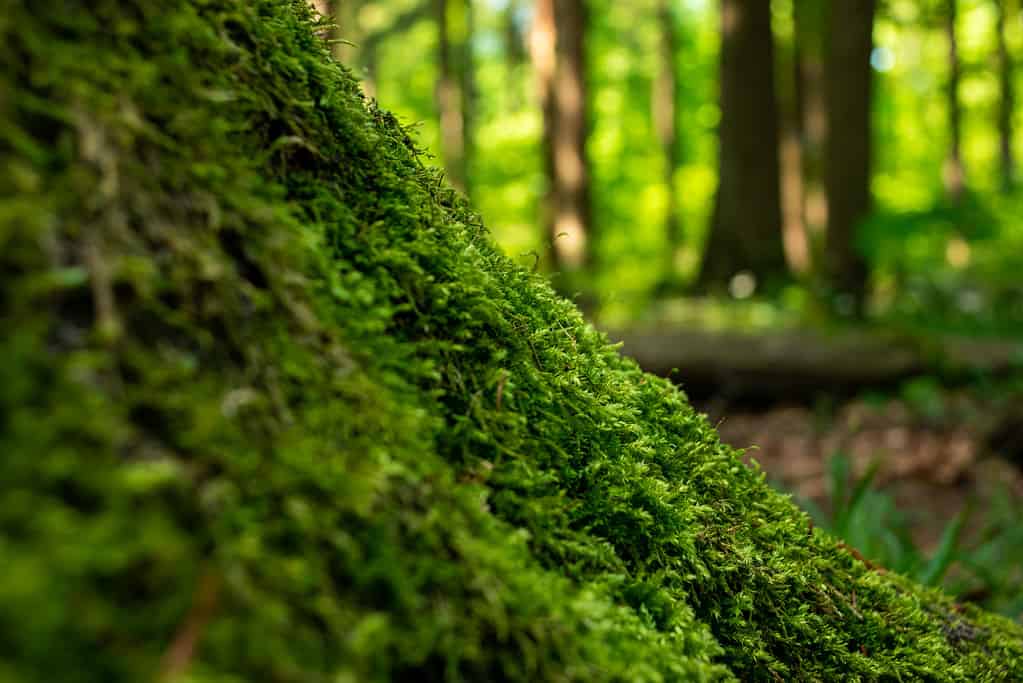Most everyone is familiar with mosses. These low-growing plants tend to coat any surface that remains moist for long periods — tree trunks, rocks, hillsides, you name it. Most people are also familiar with lichens, even if they don’t know it. They grow in the same environments as mosses, often side by side, and are frequently mistaken for mosses. But what are lichens, anyway, and how can you distinguish between these two important types of organisms?
In this article, we’ll highlight the differences between mosses and lichens. We’ll talk about how each grouping of organisms is classified, how their structures differ, and how you can tell them apart visually.
Structural Differences

Mosses are straightforward plants that grow very close to their substrates. They have no true leaves, stems, or roots.
©Octavian Lazar/iStock via Getty Images
When distinguishing between mosses and lichens, we must first examine their structures. Mosses are simple plants, falling between algae and vascular plants in complexity. They have no true leaves, stems, or roots but are capable of long-term survival on land where they can anchor themselves to surfaces and take in water and nutrients via osmosis. While algae, which are protists, can photosynthesize, they tend to be much simpler in structure and most often reside in aquatic environments. Vascular plants, on the other hand, are true plants and have specialized parts like roots, xylem, and phloem for active water and nutrient transport.

Reindeer
lichens are often called mosses and grow in fluffy clumps, usually alongside actual mosses.
©coffeechcolate/iStock via Getty Images
Lichens may sometimes look like plants but are entirely different in their structures. They are essentially compound organisms resulting from symbiotic relationships between fungi, algae, and sometimes bacteria. Not all lichens are green, but they can photosynthesize due to their algal or bacterial components. These internal powerhouses synthesize carbohydrates from sunlight, air, and water to feed themselves and their fungal partners. In return, the fungi, who produce the main body of the organism, protect their photosynthetic partners from the outside world. The algae and bacteria can survive in much dryer terrestrial environments with a chitinous fungal body to protect them.
Visual Differences
While it is usually quite apparent that mosses are plants, lichens can take on a less familiar and impressive variety of shapes and colors. In many cases, they have a crusty or rubbery texture. Some, like the reindeer lichens (Cladonia sp.), tend to resemble mosses very closely, while others, like Usnea and Umbilicaria species, can look much more alien.

Some lichens, like
Usnea, can take on an incredibly fungal and alien appearance.
©KarenHBlack/iStock via Getty Images
Lichens exhibit three primary growth forms: crustose, fruticose, and foliose. Crustose lichens grow very closely to their substrates, resembling a crust, cracking paint, or dried-on soil. They can show off various colors, from matte gray to vibrant yellow. Foliose lichens most closely resemble plants. They produce wide, flat bodies resembling simple leaves and stems that rise above their substrate. These lichens tend to flake off the surface they are growing on with little effort. The third type, the fruticose lichens, tends to look the most alien. They often take on a bushy, branching appearance resembling coral or bushy moss. This fluffy body is often decorated with cups, tubular structures, fine hair-like protrusions, or all of the above. They can be strikingly colorful and beautifully complex!
Moss vs. Lichens: Similarities

Mosses, lichens, and fungi tend to cohabitate in moist, sheltered environments where nutrients and water are readily available.
©Matteo Sisi/iStock via Getty Images
Like mosses, lichens lack root structures and must rely on osmosis to take in water. Because of this, they favor moist environments and tend to be small and low-growing. Both rely on water to spread their spores during reproduction and often grow side-by-side.
Without the ability to actively transport moisture, both organisms can only grow by the available rain or water vapor. As local and atmospheric humidity changes, so does the moisture content within their bodies. That means they are at their best during a long bout of rain, fog, or mist when they have great access to water. When there isn’t enough moisture to sustain growth during dry spells, both can go dormant. As humidity drops, their bodies can dry out almost completely, suspending their photosynthesis ability. When moisture returns, they reawaken and begin to grow again. This incredible and complex survival strategy is known as poikilohydry. Their habitats, sometimes similar appearances, and tolerance for drying out are about where the similarities between mosses and lichens end, though!
The photo featured at the top of this post is © Petra Richli/iStock via Getty Images
Thank you for reading! Have some feedback for us? Contact the AZ Animals editorial team.







